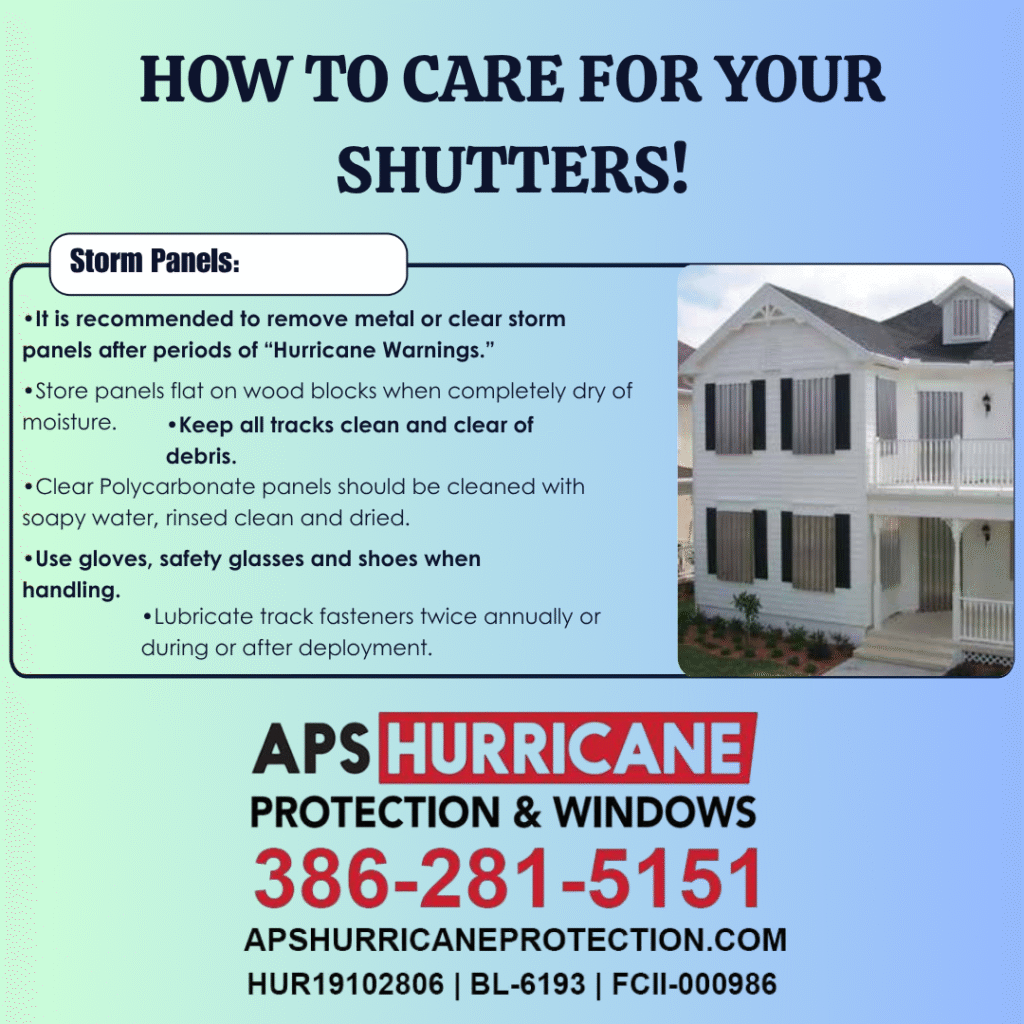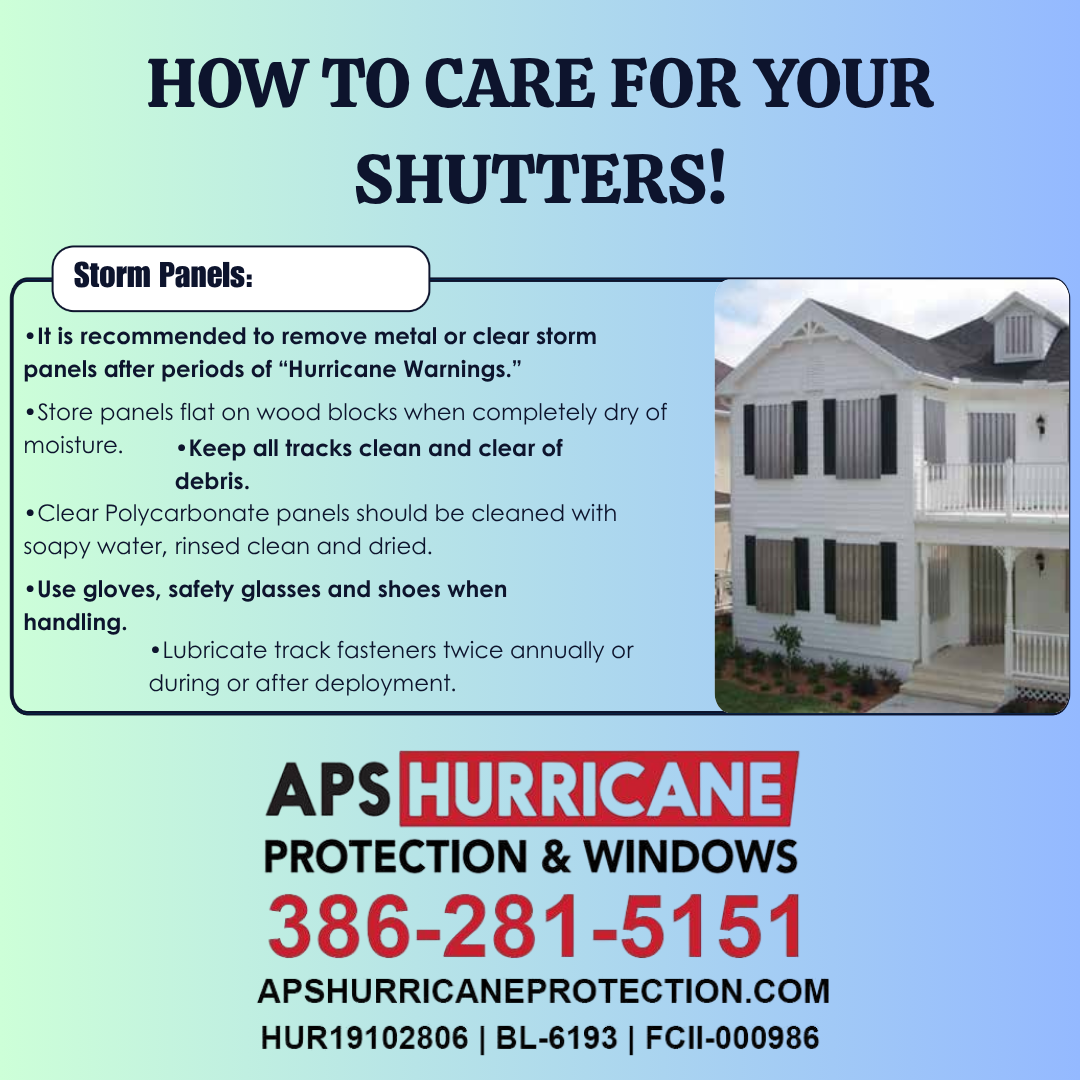Hurricane Shutter Maintenance Tips for Storm Panels
When hurricane season rolls around, your storm panels are one of the most important defenses against high winds and flying debris. Proper hurricane shutter maintenance ensures that your panels stay strong, safe, and ready when you need them most. With a little regular care, you can prevent corrosion, warping, and damage that could reduce their effectiveness.
Follow these essential maintenance tips for hurricane storm panels to extend their lifespan, keep your home secure, and make sure your shutters are ready for whatever the season brings.
1. Remove Panels After a Hurricane Warning
Once a hurricane warning has passed and conditions are safe, it’s important to remove your metal or clear storm panels. Leaving them installed for too long can trap moisture, limit airflow, and cause corrosion, mildew, or clouding—especially in humid coastal climates like Florida.
Regular removal also helps prevent dirt and salt buildup that can damage the panels and fasteners over time.
Pro Tip: Mark and label each panel by window or door location to make the next installation quicker and easier. A little organization now can save valuable time when the next storm approaches.
2. Store Panels Properly
Proper storage is key to extending the life of your hurricane shutters. Before putting your panels away, make sure they are completely dry to prevent rust or mold.
Store them flat on wood blocks or in a vertical rack inside a clean, dry space—such as a garage or storage shed. This allows airflow between panels and prevents warping. Keeping them off the ground reduces the risk of moisture damage, especially if your storage area experiences humidity or flooding.
Consider wrapping or covering them loosely with a breathable tarp to keep dust away while still allowing ventilation.
3. Keep Tracks Clean and Clear
Tracks are the foundation of your shutter system, and clean tracks mean smooth operation. Over time, dirt, salt, sand, and leaves can collect inside the track channels.
Regularly clean and clear the tracks using a small brush, vacuum, or hose. For stubborn buildup, use mild soap and water, then dry completely.
Clogged or corroded tracks can make installation difficult and even prevent your panels from locking into place securely—potentially compromising your home’s protection during a hurricane.
A quick 10-minute cleaning every few months can make a big difference in performance and longevity.
4. Clean Clear Panels the Right Way
For clear polycarbonate storm panels, proper cleaning is essential to preserve both appearance and strength. Avoid using harsh chemicals, glass cleaners with ammonia, or abrasive pads, as they can scratch or cloud the surface.
Instead, use a mixture of mild soapy water, rinse thoroughly with clean water, and dry completely using a soft microfiber cloth.
This not only keeps your panels looking like new but also ensures you maintain clear visibility through them—a valuable feature when monitoring weather conditions during a storm.
5. Practice Safe Handling
Always take safety precautions when handling storm panels. Metal panel edges can be sharp, so wear heavy-duty gloves, safety glasses, and closed-toe shoes.
When lifting large or heavy panels, ask for assistance or use proper lifting techniques to prevent injuries. If you have multiple stories, consider professional help for second-floor installations to avoid falls or damage.
Safety first ensures that both you and your storm protection equipment remain in top condition.
6. Lubricate Fasteners Regularly
A small amount of maintenance goes a long way. Apply a non-corrosive lubricant to all track bolts, wing nuts, and fasteners twice a year—once before hurricane season begins and once after it ends.
This step prevents rust, seizing, and wear, keeping your panels easy to install and remove. For coastal homes, consider lubricating more often due to salt air exposure.
When fasteners are well-maintained, you’ll be able to deploy your storm panels quickly when a hurricane warning is issued.
7. Schedule a Professional Inspection
Even with regular homeowner care, it’s wise to have a professional hurricane shutter inspection every year or two. Experts can spot signs of wear, corrosion, or structural weakness that may not be visible to the untrained eye.
They can also recommend upgrades or replacements if your panels no longer meet local building codes or if your home’s needs have changed.
Final Thoughts
Maintaining your hurricane shutters isn’t just about keeping them in good shape—it’s about protecting your home, your family, and your investment. A few minutes of preventive care before and after each hurricane season can make all the difference when severe weather threatens.
If you’d like professional help inspecting, maintaining, or upgrading your hurricane shutter system, contact APS Hurricane Protection for expert service, reliable products, and peace of mind before the next storm season.
Frequently Asked Questions (FAQ)
Q1: How often should I clean my hurricane shutters?
At least twice a year—before and after hurricane season—or more frequently if you live near the coast where salt buildup is common.
Q2: Can I leave my storm panels up all year?
It’s not recommended. Long-term installation can trap moisture and cause corrosion. Always remove them once the storm threat has passed.
Q3: What’s the best lubricant for hurricane shutter hardware?
Use a non-silicone, non-corrosive spray lubricant such as WD-40 Specialist or a marine-grade option designed for metal components.

Do you have any questions? Head over to our Contact us page and let us know!
Remember to follow us on Facebook or Instagram to stay updated!!

